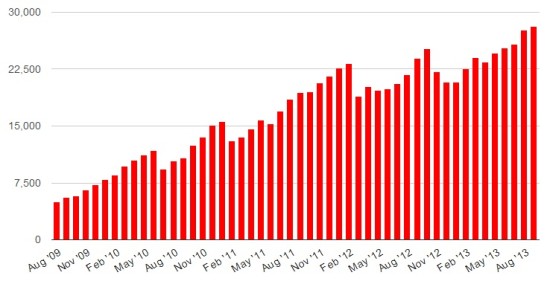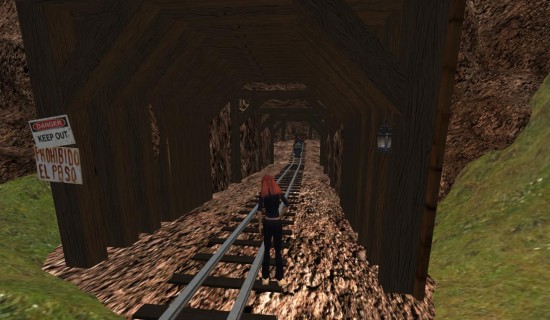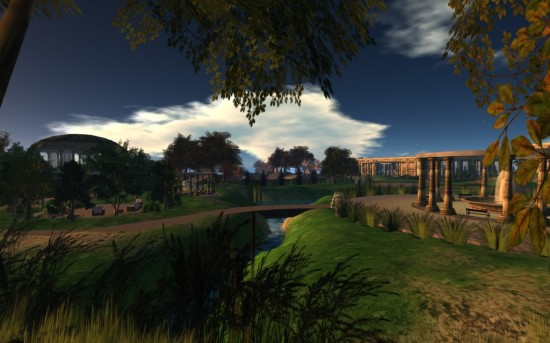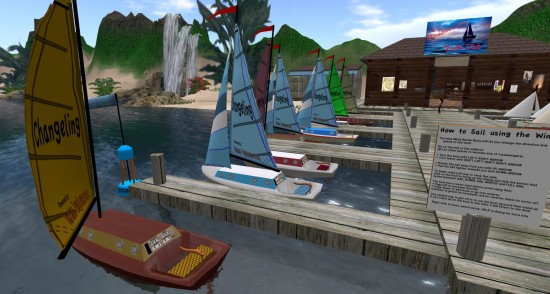The top 40 OpenSim grids have reached 28,186 Â regions, a new record high and an increase of 578 regions since this time last month. They also reported 309,792Â total registered users and 18,442Â active users this month, a total of 281 new registered users and 520 new active users.
Some of the activity may have been due to the first annual OpenSimulator Community Conference. While many attendees teleported from other grids with their existing avatars, some created new avatars for the event because they were new to OpenSim, because their home grids were not hypergrid-enabled, or to get some local functionality.

This is 1,394 more regions than on the Second Life grid.
Meanwhile, of the 281 currently active public OpenSim grids, 219 reported their statistics this month, and their land area adds up to a total of 30,417 regions — 3,625 more than on Second Life.
This count does not include private grids, such as grids run behind school firewalls, or grids set up to run large corporate simulations.
OpenSim has an edge over Second Life when it comes to land because individuals can set up regions for free, or rent regions from a number of vendors competing on both price and service at about a tenth the price of similar Second Life regions.
However, as can be seen from the active user numbers, OpenSim still isn’t a match for Second Life in terms of community. As a result, people coming to OpenSim either bring their own communities with them — such as schools and role playing groups — or don’t need communities, such as independent builders and creators.
Some users mix-and-match, using Second Life for social events, and OpenSim for creating.
There are also several grids actively trying to build communities for their residents.
Popularity
For company and school grids, relative popularity is not an issue — the grids are set up for a specific purpose, and if they meet that purpose, then they are successful. The same is true for grids run by niche communities or that serve a special purpose not found elsewhere.
But when it comes to general-purpose social grids, the rule of thumb is: the bigger and busier, the better. People looking to make new friends look for grids that already have the most users. Merchants looking to sell content will go to the grids with the most potential customers. Event organizers looking for the biggest audience… you get the idea.
With that in mind, here are the 10 most popular grids this month:
- InWorldz: 7,160 active users
- OSgrid: 3,563Â active users
- Avination: 1,972 active users
- Metropolis: 1,157 active users
- Island Oasis: 1,101 active users
- OpenSimulator Community Conference: 1,074 active users
- Craft World: 531 active users
- Kitely: 497 active users
- 3rd Rock Grid: 421 active users
- Littlefield: 302 active users
There were no relative changes in rankings, except for the OSCC grid moving up one notch as a result of the conference. The OSCC was also the single biggest gainer of new users, as 586 of their active users were new. The previous month, there was no convention, but there were large load tests that attracted a few hundred avatars.
Of other grids, the commercial InWorldz grid reported 266 more active users this month, and 3rd Rock Grid reported 69 more users. OSgrid reported the biggest loss, with 210 fewer active users than in August. Avination lost 61 active users.
News from around the grids
The amount of news coming in from the grids is continuing to grow. So, next month, I’m going to break this article in two.
The first piece, just the grid news, will run at the start of the month, at or near October 1, and will feature announcements and upcoming events for the month of October.
The stats will continue to come out at or near the 15th of each month, as they’ve done now for four years. (Has it really been that long?)
Please mark your calendars and send announcements to maria@hypergridbusiness.com near the end of September. Announcements can include upcoming events, new merchants, new malls, major new builds and attractions, discounts and sales, new hires, help wanted announcements — anything that can be summarized in a paragraph or two. Please include snapshots and photos!
Mystery-themed world opens
The mystery-themed grid Ruby Virtual World has opened its doors and is looking for actors to play roles in in-world mysteries.
The grid also offers homes and shops for rent at US $5 per month, using the PayPal payment system.

Olantica, Zandramas grids announce merger
The Olantica grid, a mid-sized commercial grid with 41 regions at last count and 79 active users, has announced that it is merging with the slightly larger Zandramas grid.
“We feel this will be a more stable setup for the long term with better performance,” Olantica’s grid owners said in an announcement.
Not all content will survive the move, however. Instead of simply uploading all avatars and their inventories to the new grid, and moving over the region files, the grid owners have decided to filter out proprietary content first.
“Due to legal issues we can’t just transfer your inventories in their entirety,” said the announcement. “Most inventories contain items that are created by other people. Unfortunately we won’t be able to reach everyone to get permission to transfer content to Zandramas… If you have stuff that is created by someone that you really want to have in Zandrams you can help us out by contacting the content creator and asking if it’s okay. The content creator will need to get in touch with us with some kind of verification they are the creator of the content and give us permission to move the content.”
In anticipation of this happening on other grids, commercial operators should double-check that their terms of service allow for full migration of content if their grid merges with another grid, so that users don’t lose inventory that they’ve already paid for.
Shop owners have to specifically request that their content be moved.
“If you have a shop in Olantica that you wish to port over to Zandramas or a region, please make sure that all the content is 100 percent yours and send Dno Vale a note card in Olantica giving your permission to move the content over,” the grid owners said.
“This way, when we make a back up of a region, we know not to remove your content first before porting it over to its new home in Zandramas. Please note if we don’t get permission from you to move your content we will have to remove it when porting over to Zandramas.”
Kitely Market Opens
This should be old news to our readers, but the Kitely Market is officially open after nine months of development work.

“Despite only being open for just two weeks, and still missing the ability to automatically deliver to all hypergrid-connected grids, we’re already seeing a good growth in the number of people using Kitely Market to sell and buy virtual goods,” Kitely CEO Ilan Tochner told Hypergrid Business. “The number of listed product variations now exceeds 1,100 items in more than 800 separate product listings.”
For more information about the Kitely Market, see my stories Kitely Market vs Second Life Marketplace, which compares the functionality of the two platforms, and Kitely Marketplace launched, and also their very detailed announcement here.
Kitely has also released its first update to the market, a set of tools for merchants to help them debug their products. Merchants who don’t own land on Kitely can still use these tools for free via the open access Kitely Merchants Sandbox.
Tochner also delivered a presentation about the market at the OpenSim Community Conference, and the video and slides are available here.

Finally, the Kitely Mentors Group and other community members have built a new Welcome Center for the grid.
“This beautiful always-on world contains helpful information about Kitely, so when new users join Kitely we invite them to first visit this world,” said Tochner. “This world will also be used for community activities such as the weekly Kitely Mentors group meeting.”
Femdom grid Avalonia holds grand opening Sunday
Avalonia Estate, a social grid focusing on niche alternative lifestyle roleplay, specifically serving the femdom community, held its grand opening party this past Sunday.
Since announcing the grid last month, the grid has gained another content creator –Â Audria McCallen of Second Life’s Bloody Rose Designs — specializing in male and female clothing, furniture, and other content.
“Our grid has grown infrastructure wise,” grid founder Justin Ireman told Hypergrid Business. “We have rented more hardware to ensure greater stability and reliability. Â I have implemented a professional back-end support ticketing system for support requests, along with a new account services portal for our residents. Â We have implemented in-world partnering, as well as providing our new residents with new starter avatars, so they don’t have to come in world on their first visit as a Ruth.”
In addition, the grid now provides a free email account to all premium members, so that they don’t need to give out their personal email addresses.
>Avalonia, which is hypergrid-enabled, has also set up a procedure for handling hypergrid abuse reports — both of foreign avatars causing trouble on the Avalonia grid, and Avalonian users causing trouble elsewhere.
“I think this is a sensible approach and we at Avalonia Estate want to be a responsible member of the Open Metaverse,” said Ireman.
According to the policy, the grid will respond within 24 hours to reports of griefing by Avalonia residents on other grids.
“Avalonia Estate does not tolerate our account holders griefing or abusing others in foreign grids, and we would like to apologise in advance should that have happened,” the policy says.
Tangle Grid offers free three-month rent on homes, shops
Tangle Grid is new to our database this month and to attract new residents and merchants, the grid offers first three months free for shop and apartment rentals. After that, regular rates apply, of US $1 per month.
The grid also offers full 22,000-prim regions for US $22 a month.
Wind-driven sailboats on Virtual Highway
The Virtual Highway grid has its first wind-driven sailboats, grid owner Gene Call told Hypergrid Business.
“We have a new sailboat from Kayaker Magic that is working great on OpenSim,” he said.
Interested residents can stop by the Paradise Cove Yacht Club, with sailing lessons on Sunday evenings and by prior arrangement at other times.
The grid is also holding a Halloween-themed building contest and a movie theme contest starting October 1, with a dedicated region and a V$ 5,000 prize for the movie contest winner.
MOSES migrates to Simian, Freeswitch
The U.S. Army’s MOSES grid — which stands for Military Open Simulator Enterprise Strategy — has migrated from Robust to Simian central grid services, and from the Whisper to the Freeswitch open source voice system.
The migration to SimianGrid, which is a system of tools designed to help run a grid’s central systems and Web front end, has resulted in easier automation of user functions, said grid administrator Douglas Maxwell, the U.S. Army Simulation & Training Center’s Science and Technology Manager for Virtual World Strategic Applications.
“You can do things like assign default avatars easier through scripts,” he told Hypergrid Business. “Before, using Robust, it was extremely difficult to go beyond just the male and female default avatars.”
Now, the grid can have different default avatars for military and civilian personnel — or even for different military ranks and different civilian jobs.
In addition, grid users can now upload and download their regions’ OAR files, and their avatars’ IAR inventory files.
These new functions are all part of the Moses Grid Manager, and will be donated to the public.
“We’ll toss it up on github, most likely,” Maxwell said. “That seems to be something the majority of our partners are comfortable with. I personally have an affinity for SourceForge, but it looks like I’m going to be outvoted here.”
The move away from the Whisper-Mumble voice system was due to the fact that it required a custom viewer plugin, which was not available for Macintosh users.
Switching to Freeswitch wasn’t easy, Maxwell said, especially given the military’s security requirements. But now the Moses grid can be accessed via any viewer, not just the custom Moses viewer.
Most other grids use the Vivox voice, the same platform as used by Second Life, which is free for small and non-profit grids. However, Vivox voice traffic is handled by Vivox company servers, which creates a security issue.
As part of the migration, Moses users had to re-create their avatars, which has resulted in a drop of registered users on the grid.
Transitions
We’re listing 71 grids as suspended this month because we haven’t been able to get to their grid info pages or websites this month.
Meanwhile, we’ve added several new grids to our database, including PierSimConnect, Islands of Enlightenment, Extension, Wimurion, Tangle Grid, Prince of Songkla University, Realms in Time, Virtual Theology University, OpenSim Fuchs, DeasantaGrid, Youngland, Britannia, Jameson Grid, Esoteric, BIOME4KIDS, Snoodle Life, The Verse, and ScienceCircle.
If there’s a public grid we’re not tracking, please email us at editor@hypergridbusiness.com. There’s no centralized way to find OpenSim grids, so if you don’t tell us about it, and Google doesn’t alert us, we won’t know about it.
The official OpenSim website – OpenSimulator.org – began tracking download numbers for the software in January. The software was downloaded 953 times this month, for a total of over 14,000 downloads since the start of this year.
The stats page for the Diva Distro, a more user-friendly version of OpenSim, reported 877 downloads this month, for a grand total of over 24,000 downloads since the distribution was first released in May of 2011.
Sim-on-a-Stick, a packaged version of the Diva Distro, was downloaded 1,083 times this month, for over 23,000 downloads total since the distribution was first released in May 2011.
Meanwhile, according to data from The Hypergates, the number of hypergate jumps on their network this month decreased by 309, to 3,034. The system now has 706 registered hypergates, up by 89 from last month, on 65 different grids.
This data is very limited, however. For example, not all hypergates are part of The Hypergates network — anyone can create their own hypergate by dropping a script on any object, such as our touch or walk-through single-destination hypergate script. In addition, many people do hypergrid jumps without using any gate at all, simply by typing a hypergrid address into Map-Search, or by using a hypergrid landmark created during a previous jump. There is currently no way of tracking that traffic.
Meanwhile, Second Life continued to lose land, according to data from GridSurvey, with 107 fewer regions today than the same time last month. The Second Life grid now has 26,792 Â regions total, down 2,110 regions from this time last year, and 5,093 fewer regions than its peak in June of 2010. According to GridSurvey, the last time the grid was this small was in May of 2009.
September Region Counts on the Top 40 Grids
The list below is a small subset of existing OpenSim grids. We are now tracking a total of 706 different publicly-accessible grids, 281 of which were active this month, and 218 of which published their statistics. There were a total of 30,413 regions, 327,298 registered users, and 21,786 active users on those 218 grids.
Many school, company or personal grids do not publish their numbers.
The raw data for this month’s report is here. A list of all active grids is here.
- OSGrid: 11,245 regions
- Kitely: 4,567 regions
- Metropolis: 3,209 regions
- InWorldz: 1,265 regions
- ScienceSim: 1,160 regions
- Virtual Worlds Grid: 933 regions
- Avination: 642 regions
- Moses: 400 regions
- Lost Paradise: 361 regions
- 3rd Rock Grid: 305 regions
- Virtual Highway: 241 regions
- FrancoGrid: 233 regions
- Grid Nirvana: 220 regions
- Island Oasis: 207 regions
- Open Virtual Worlds: 181 regions
- SimudyneGrid: 177 regions
- Craft World: 165 regions
- Real Country: 164 regions
- Athabasca University: 160 regions
- Adreans-World: 158 regions
- SimValley: 155 regions
- Logicamp: 152 regions
- Littlefield: 147 regions
- Dorena’s World: 137 regions
- Ingen-Lab: 128 regions
- Anettes Welt: 126 regions
- OpenSim.ru: 122 regions
- A Virtual World: 120 regions
- AviWorlds: 117 regions
- Virtyou: 110 regions
- Infinite Grid: 108 regions
- Homeland3D: 98 regions
- PMGrid: 96 regions
- Zandramas: 91 regions
- Neuland: 90 regions
- GerGrid: 83 regions
- iSynergy3D: 83 regions
- DreamNation: 80 regions
- YourSimSpot: 76 regions
- German Grid: 74 regions
- Kitely Mega Worlds on sale for $90 per month - July 19, 2024
- OpenSim regions up, actives down with summer heat - July 15, 2024
- People think AIs are conscious. What could this mean for bots in OpenSim? - July 12, 2024

